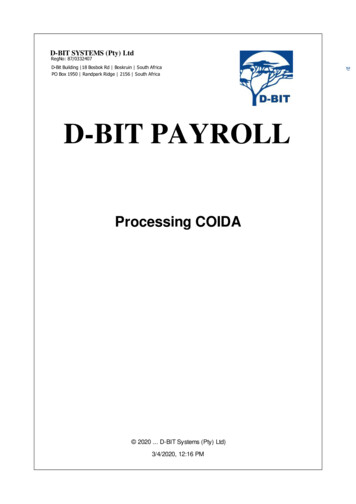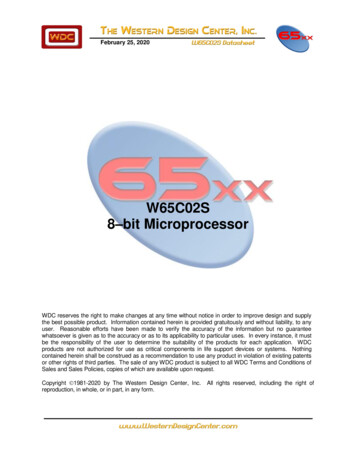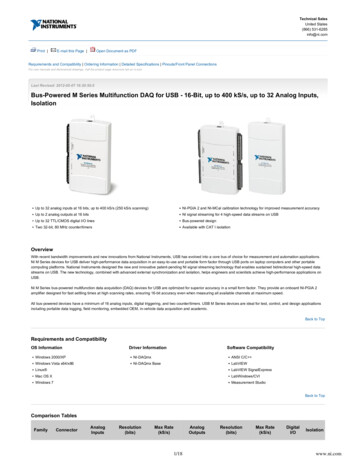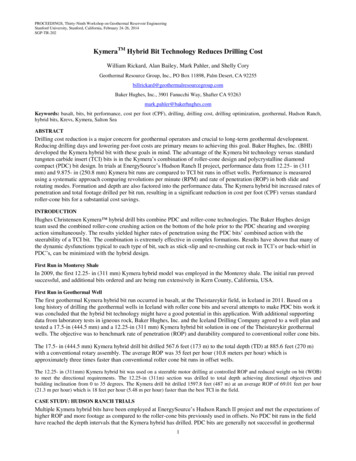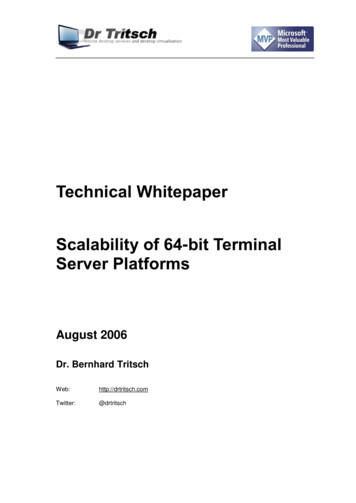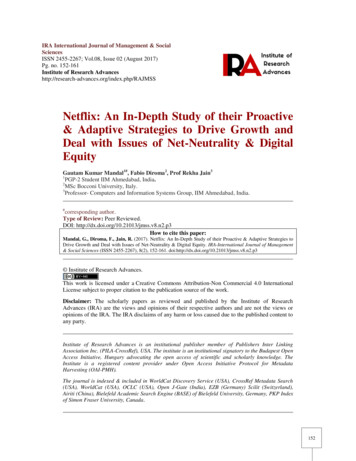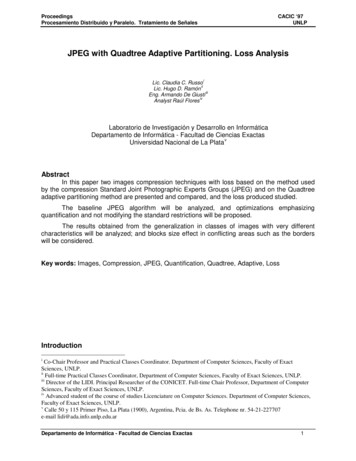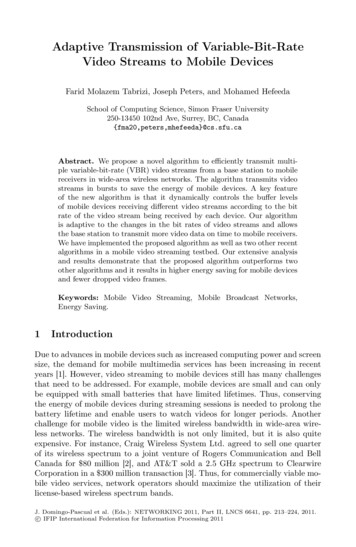
Transcription
Adaptive Transmission of Variable-Bit-RateVideo Streams to Mobile DevicesFarid Molazem Tabrizi, Joseph Peters, and Mohamed HefeedaSchool of Computing Science, Simon Fraser University250-13450 102nd Ave, Surrey, BC, Canada{fma20,peters,mhefeeda}@cs.sfu.caAbstract. We propose a novel algorithm to efficiently transmit multiple variable-bit-rate (VBR) video streams from a base station to mobilereceivers in wide-area wireless networks. The algorithm transmits videostreams in bursts to save the energy of mobile devices. A key featureof the new algorithm is that it dynamically controls the buffer levelsof mobile devices receiving different video streams according to the bitrate of the video stream being received by each device. Our algorithmis adaptive to the changes in the bit rates of video streams and allowsthe base station to transmit more video data on time to mobile receivers.We have implemented the proposed algorithm as well as two other recentalgorithms in a mobile video streaming testbed. Our extensive analysisand results demonstrate that the proposed algorithm outperforms twoother algorithms and it results in higher energy saving for mobile devicesand fewer dropped video frames.Keywords: Mobile Video Streaming, Mobile Broadcast Networks,Energy Saving.1IntroductionDue to advances in mobile devices such as increased computing power and screensize, the demand for mobile multimedia services has been increasing in recentyears [1]. However, video streaming to mobile devices still has many challengesthat need to be addressed. For example, mobile devices are small and can onlybe equipped with small batteries that have limited lifetimes. Thus, conservingthe energy of mobile devices during streaming sessions is needed to prolong thebattery lifetime and enable users to watch videos for longer periods. Anotherchallenge for mobile video is the limited wireless bandwidth in wide-area wireless networks. The wireless bandwidth is not only limited, but it is also quiteexpensive. For instance, Craig Wireless System Ltd. agreed to sell one quarterof its wireless spectrum to a joint venture of Rogers Communication and BellCanada for 80 million [2], and AT&T sold a 2.5 GHz spectrum to ClearwireCorporation in a 300 million transaction [3]. Thus, for commercially viable mobile video services, network operators should maximize the utilization of theirlicense-based wireless spectrum bands.J. Domingo-Pascual et al. (Eds.): NETWORKING 2011, Part II, LNCS 6641, pp. 213–224, 2011.c IFIP International Federation for Information Processing 2011
214F. Molazem Tabrizi, J. Peters, and M. HefeedaIn this paper, we consider the problem of multicasting multiple video streamsfrom a wireless base station to many mobile receivers over a common wirelesschannel. This problem arises in wide-area wireless networks that offer multimedia content using multicast and broadcast services, such as DVB-H (Digital Video Broadcast-Handheld) [4], ATSC M/H (Advanced Television SystemsCommittee-Mobile/Handheld) [5], WiMAX [6], and 3G/4G cellular networksthat enable the Multimedia Broadcast Multicast Services (MBMS) [7]. We propose a new algorithm to efficiently transmit the video streams from the basestation to mobile receivers. The transmission of video streams is done in burststo save the energy of mobile devices. Unlike previous algorithms in the literature,e.g. [8,9,10,11,12], the new algorithm adaptively controls the buffer levels of mobile devices receiving different video streams. The algorithm adjusts the bufferlevel at each mobile device according to the bit rate of the video stream beingreceived by that device. The algorithm also uses variable-bit-rate (VBR) videostreams, which are statistically multiplexed to increase the utilization of the expensive wireless bandwidth. By dynamically adjusting the receivers’ buffers, ouralgorithm enables finer control of the wireless multicast channel and allows thebase station to transmit more video data on time to mobile receivers.We have implemented our new algorithm in an actual mobile video streamingtestbed that fully complies with the DVB-H standard. We have also implementedthe recent algorithm proposed in [8] and an algorithm used in some commercialbase stations for broadcasting VBR video streams [13], which we know throughprivate communication [14]. Our empirical results demonstrate the practicalityof our new algorithm. Our results also show that our algorithm outperformsother algorithms as it delivers more video frames on-time to mobile receiversand it achieves high energy saving for mobile receivers.The rest of this paper is organized as follows. We review related work inSection 2. In Section 3, we describe the wireless network model that we considerand we state the problem addressed in this paper. We present the proposedalgorithm in Section 4. We empirically evaluate our algorithm and compare itagainst others in Section 5. We conclude the paper in Section 6.2Related WorkEnergy saving at mobile receivers using burst transmission (aka time slicing) hasbeen studied in [9, 10]. Simulations are used in these studies to show that timeslicing can improve energy saving for mobile receivers. However, no burst transmission algorithms are presented. Burst transmission algorithms for constantbit-rate (CBR) video streams are proposed in [11, 15]. These algorithms cannothandle VBR video streams with fluctuating bit rates. In this paper, we considerthe more general VBR video streams which can achieve better visual quality andbandwidth utilization [16]. In [12], we presented a burst transmission techniquedesigned for scalable video streams. The algorithm in [12] adjusts the numberof transmitted quality layers based on the available bandwidth. However, unlikethe algorithm presented in this paper, our previous algorithm does not support
Adaptive Transmission of VBR Video Streams to Mobile Devices215VBR streams, nor does is dynamically adjusts the receivers’ buffers. In addition,the new algorithm in this paper is designed for single-layer VBR video streams,which are currently the most common in practice.Transmitting VBR video streams over a wireless channel while avoiding bufferoverflow and underflow at mobile devices is a difficult problem [17]. Rate smoothing is one approach to reducing the complexity of this problem. The smoothingalgorithms in [18, 19] reduce the complexity by controlling the transmission rateof a single video stream to produce a constant bitrate stream. The minimum requirements of rate smoothing algorithms in terms of playback delay, lookaheadtime, and buffer size are discussed in [20]. The on-line smoothing algorithmin [21] reduces the peak bandwidth requirements for video streams. However,none of these smoothing algorithms is designed for mobile multicast/broadcastnetworks with limited-energy receivers. A different approach to handling VBRvideo streams is to employ joint rate control algorithms. For example, Rezaeiet al. [22] propose an algorithm to assign bandwidth to video streams proportional to their coding complexities. This algorithm, however, requires expensivejoint video encoders. A recent algorithm for transmitting VBR video streams tomobile devices without requiring joint video encoders is presented in [8]. Thisalgorithm, called SMS, performs statistical multiplexing of video streams. SMSdivides the receivers’ buffers into two equal parts, one for receiving data, and theother for playing out video. The proposed algorithm in this paper outperformsSMS because it dynamically controls the wireless channel and the buffer levelsof the receivers. This allows the base station to exploit the varying nature ofVBR streams in order to transmit more video frames on time.The VBR transmission algorithms deployed in practice are simple heuristics.For example, in the Nokia Mobile Broadcast Solution (MBS) [13,14], the operatordetermines a bit rate value for each video stream and a time interval based onwhich bursts are transmitted. The time interval is calculated on the basis of thesize of the receiver buffers and the largest bit rate among all video streams, andthis time interval is used for all video streams to avoid buffer overflow instancesat the receivers. In each time interval, a burst is scheduled for each video streambased on its bit rate. In practice, it is difficult for an operator to assign bit ratevalues to VBR video streams to achieve good performance while avoiding bufferunderflow and overflow instances at the receivers. In this paper, we compareour proposed algorithm to the SMS algorithm [8] (which represents the state-ofthe-art in the literature) as well as to the algorithm used in the Nokia MobileBroadcast Solution (which represents one of the state-of-the-art algorithms inpractice).3System Model and Problem StatementWe study the problem of transmitting several video streams from a wirelessbase station to a large number of mobile receivers. We focus on multicast andbroadcast services enabled in many recent wide-area wireless networks such asDVB-H [4], MediaFLO [23], WiMAX [6], and 3G/4G cellular networks that
216F. Molazem Tabrizi, J. Peters, and M. HefeedaReceivers 1 statusONBase StationSLEEPONSLEEPONReceivers 1Receivers 2Receivers 3Fig. 1. The wireless network model considered in this paperoffer Multimedia Broadcast Multicast Services (MBMS) [7]. In such networks,a portion of the wireless spectrum can be set aside to concurrently broadcastmultiple video streams to many mobile receivers. Since the wireless spectrumin wide-area wireless networks is license-based and expensive, maximizing theutilization of this spectrum is important. To achieve high bandwidth utilization,we employ the variable-bit-rate (VBR) model for encoding video streams. Unlikethe constant-bit-rate (CBR) model, the VBR model allows statistical multiplexing of video streams [8], and yields better perceived video quality [16]. However,the VBR model makes video transmission much more challenging than the CBRmodel in mobile video streaming networks [17].Mobile receivers are typically battery powered. Thus, reducing the energyconsumption of mobile receivers is essential. To save energy, we employ the bursttransmission model for transmitting video streams, in which the base stationtransmits the data of each video stream in bursts with a bit rate higher thanthe encoding bit rate of the video. The burst transmission model allows a mobiledevice to save energy by turning off its wireless interface between the receptionof two bursts [15, 17]. The arrival time of a burst is included in the headerof its preceding burst. Thus, the clocks at mobile receivers do not need to besynchronized. In addition, each receiver is assumed to have a buffer to store thereceived data. Figure 1 shows a high-level depiction of the system model thatwe consider.To achieve the burst transmission of video streams described in Figure 1,we need to create a transmission schedule which specifies for each stream thenumber of bursts, the size of each burst, and the start time of each burst. Notethat only one burst can be transmitted on the broadcast channel at any time.The problem we address in this paper is to design an algorithm to create atransmission schedule for bursts that yields better performance than currentalgorithms in the literature.In particular, we study the problem of broadcasting S VBR video streams froma base station to mobile receivers in bursts over a wireless channel of bandwidth RKbps. The base station runs the transmission scheduling algorithm every Γ sec;we call Γ the scheduling window. The base station receives the video data belonging to video streams from streaming servers and/or reads it from local videodatabases. The base station aggregates video data for Γ sec. Then, it computesfor each stream s the required number of bursts. We denote the size of burst k of
Adaptive Transmission of VBR Video Streams to Mobile Devices217video stream s by bsk (Kb), and the transmission start time for it by fks sec. Theend time of the transmission for burst k of stream s is fks bsk /R sec.After computing the schedule, the base station will start transmitting burstsin the next scheduling window. Each burst may contain multiple video frames.We denote the size of frame i of video stream s by lis (Kb). Each video frame ihas a decoding deadline, which is i/F , where F is the frame rate (fps). The goalsof our scheduling algorithm are: (i) maximize the number of frames delivered ontime (before their decoding deadlines) for all video streams, and (ii) maximizethe average energy S saving for all mobile receivers. We define the average energysaving as γ s 1 γs /S, where γs is the fraction of time the wireless interfacesof the receivers of stream s are turned off.44.1Proposed AlgorithmOverviewWe start by presenting an overview of the proposed algorithm and then wepresent the details. We have proved that our algorithm produces near-optimalenergy saving and that it runs in time O(N S), where S is the number of videostreams and N is the total number of control points defined for the video streams,but we have omitted the proofs due to space limitations.We propose a novel algorithm, which we call the Adaptive Data Transmission(ADT) algorithm, to solve the burst transmission problem for the VBR videostreams described in Section 3. The key idea of the algorithm is to adaptivelycontrol the buffer levels of mobile devices receiving different video streams usingdynamic control points. The buffer level at each mobile device is adjusted as afunction of the bit rate of the video stream being received by that device. Sincewe consider VBR video streams, the bit rate of each video is changing with timeaccording to the visual characteristics of the video. This means that the bufferlevel at each mobile device is also changing with time. The receiver buffer levelis controlled through the sizes and timings of the bursts transmitted by the basestation in each scheduling window. The sizes and timings of the transmittedbursts are computed by the proposed ADT algorithm at dynamically definedcontrol points. Dynamic control points provide flexibility to the base station sothat the algorithm has more control over the bandwidth when the bit rates ofvideo streams increase. This results in transmitting more video data on time tomobile receivers.The ADT algorithm defines control points at which it makes decisions aboutwhich stream should have access to the wireless medium and for how long itshould have access. Control points for each video stream are determined basedon a parameter α, where 0 α 1. This parameter is the fraction of B, thereceiver’s buffer, that is played out between two control points of a video stream.The parameter α can change dynamically between scheduling windows but is thesame for all video streams. At a given control point, the base station selects astream and computes the buffer level of the receivers for the selected streamand can transmit data as long as there is no buffer overflow at the receivers.
218F. Molazem Tabrizi, J. Peters, and M. HefeedaOur algorithm is designed for broadcast networks where there is no feedbackchannel, so we cannot know the buffer capacity of every receiver. We assumeB to be the minimum buffer capacity for the receivers. Therefore, the receivershave a buffer capacity of at least B Kb and our solution still works if some ofthem have larger buffer capacities.For small values of α, control points are closer to each other (in time) whichresults in smaller bursts. This gives the base station more flexibility when deciding which video stream should be transmitted to meet its deadline. That is, thebase station has more opportunities to adapt to the changing bit rates of thedifferent VBR video streams being transmitted. For example, the base stationcan quickly transmit more bursts for a video stream experiencing high bit rate inthe current scheduling window and fewer bursts for another stream with low bitrate in the current scheduling window. This dynamic adaptation increases thenumber of video frames that meet their deadlines from the high-bit rate streamwhile not harming the low-bit rate stream. However, smaller bursts may resultin less energy saving for the mobile receivers.Each time that a wireless interfaceis turned on, it incurs an energy overhead because it has to wake up shortlybefore the arrival of the burst to initialize its circuits and lock onto the radiofrequency of the wireless channel. We denote this overhead by To , which is onthe order of msec depending on the wireless technology.4.2DetailsThe proposed ADT algorithm is to be run by the wireless base station to schedulethe transmission of S video streams to mobile receivers. The algorithm can becalled periodically every scheduling window of length Γ sec, and whenever achange in the number of video streams occurs.We define several variables that are used in the algorithm. Each video streams is coded at F fps. We assume that mobile receivers of video streams have abuffer capacity of B Kb. We denote the size of frame i of video stream s by lis(Kb). We denote the time that the data in the buffer of a receiver of stream scan be played out by ds sec. This means that it takes ds sec until the buffer of areceiver of video stream s is drained. We use the parameter M (Kb) to indicatethe maximum size of a burst that could be scheduled for a video stream in ouralgorithm when there are no other limitations like buffer size. In some wirelessnetwork standards, there might be limitations on the value of M . A controlpoint is a time when the scheduling algorithm decides which stream should beassigned a burst. A control point for video stream s is set every time the receiverhas played out αB Kb of video data.Let us assume that the algorithm is currently computing the schedule for thetime window tstart to tstart Γ sec. The algorithm defines the variable tschedule andsets it equal to tstart . Then, the algorithm computes bursts one by one and keepsincrementing tschedule until it reaches the end of the current scheduling window,i.e., tstart tschedule tstart Γ . For instance, if the algorithm schedules aburst of size 125 Kb on a 1 Mbps bandwidth, then the length of this burst will be0.125 sec and the algorithm increments tschedule by 0.125 sec. The number of video
Adaptive Transmission of VBR Video Streams to Mobile Devices219frames of video stream s that are sent until time tschedule is denoted by ms . Thenumber of frames of stream s that are played out at the receiver side of stream suntil time tschedule is ps min(ms , tschedule F ). If ps ms , then frames ps 1 toms are still in the receivers’ buffers. If ps ms , then the buffers of the receivers ofvideo stream s are empty. In this case, the receivers of video stream s are waitingfor data and if ms tschedule F , some video frames were not received on time.We define the playout deadline for stream s as:ds (ms ps )/F.(1)The next control point hs of stream s after time tschedule will be when thereceivers of stream s have played out αB Kb of video data. We compute thenumber of frames gs corresponding to this amount as follows:p s gslis αB i psps gs 1 lis .(2)i psThe control point hs is then given by:hs tschedule gs /F.(3)The high-level pseudo-code of the ADT algorithm is given in Figure 2. Thealgorithm works as follows. At each control point, the algorithm finds the streams which has the closest deadline ds . Then it finds the stream s with the closestcontrol point hs . Then the algorithm schedules a burst for stream s until thecontrol point hs if this does not exceed the maximum burst size M or theavailable buffer space at the receivers of s . Otherwise, the size of the new burstis set to the minimum of M and the available buffer space. The algorithm repeatsthe above steps until there are no more bursts to be transmitted from the videostreams in the current scheduling window, or until tschedule exceeds tstart Γ andthere remains data to be transmitted.
Adaptive Transmission of VBR Video Streams to Mobile Devices 217 video stream s by bs k (Kb), and the transmission start time for it by f s k sec. The end time of the transmission for burstk of streams is fs k b s k/R sec. After computing the schedule
